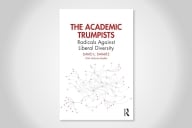You have /5 articles left.
Sign up for a free account or log in.
Scholars up to the age of 35 used to dominate authorship of articles in top economics journals. But a new study finds that the profession -- at least as judged by publication -- has aged dramatically since the 1960s. And the study also found that while women have made notable gains in top economics journals, those gains lag their growing representation in the discipline.
The study was conducted by Daniel S. Hamermesh, the Sue Killam Professor in the Foundation of Economics at the University of Texas at Austin, and was just released by the National Bureau of Economic Research (abstract available here). Hamermesh looked at all of the articles published in three leading economic journals for one year in each of the last six decades: 1963, 1973, 1983, 1993, 2003 and 2011. He was able to identify 1,100 different authors of 1,269 papers, the gender for all authors, and the age at publication of all except the author of one paper in 1963. The journals were American Economic Review, Journal of Political Economy and Quarterly Journal of Economics. (Speeches and short notes and replies were excluded, so that the focus would be on peer-reviewed articles.)
The shift, particularly in the last two decades, has been dramatic. Publishing in the top journals was once a "young person's game," appropriate for a field that prides itself on younger scholars making key breakthroughs and where publication in one of these journals would be a huge boost to a tenure bid, Hamermesh writes. But that's no longer the case.
In the years Hamermesh examined for the '60s and '70s, the majority of authors were under the age of 36, and not even 6 percent of papers had authors over the age of 50. Now, only a third of papers are written by those under 36 and just under 19 percent are by authors over 50.
Age of Authorship for Papers in Top Economics Journals
| Year | <=35 | 36-50 | 51-60 | 61+ |
| 1963 | 50.5% | 45.3% | 2.4% | 1.8% |
| 1973 | 61.5% | 32.6% | 5.9% | 0% |
| 1983 | 48.5% | 47.2% | 3.5% | 0.8% |
| 1993 | 49.8% | 43.1% | 5.6% | 1.5% |
| 2003 | 36.8% | 50.4% | 10.7% | 2.1% |
| 2011 | 33.0% | 48.1% | 13.0% | 5.9% |
Hamermesh considers -- and rejects -- some demographic explanations for the advancing age of those publishing in top journals. It's not because it takes longer to earn Ph.D.s, because it actually turns out that the average age of earning an economics Ph.D. is now just under 32, while it was just over 32 in the 1960s.
Another explanation some might offer is that economics is a more international field now, and perhaps the non-American scholars are publishing at older ages. This theory is only half-right. Hamermesh shows that the percentage of North American authors in these journals has dropped from 92 percent in the early decades he studied to 83 percent for the last two decades. But authors based in the U.S. or Canada are, on average, a few months older than the authors from outside North America.
More plausible explanations, he suggest, may relate to the end of mandatory retirement in higher education. Not only are more faculty members sticking around longer, but they may have incentives to publish, he writes, because salaries of senior professors have fallen relative to those of junior professors.
The figures for women show growth.
Percentage of Female Authors in Top Economics Journals
| Year | Female Authors |
| 1963 | 4.7 |
| 1973 | 3.4 |
| 1983 | 6.8 |
| 1993 | 9.3 |
| 2003 | 10.3 |
| 2011 | 12.6 |
While one might look at those gains and see progress, Hamermesh cautions against that. About 30 percent of those in tenure-track positions in economics are women, he notes, So they appear far less likely than men to publish in the leading journals. And for those who might think this will disappear as the cohorts entering the discipline (with larger shares of women) advance, he writes that this isn't necessarily true. For the 2003 and 2011 years, only 16 percent of authors under 36 were women.
Hamermesh also notes shifts in the methodology of articles published. Theory was dominant in the 1960s, 70s and 80s, but empirical research is now much more popular. He writes that the trends away from theory and toward older authors appear consistent with one another because of the view in the field that "thinkers reach their peak productivity at younger ages in areas requiring more mathematical thinking." But he then adds that he found older authors more likely than others to publish theory articles.
While Hamermesh expects the trends on age to continue, given that the mandatory retirement age is not coming back any time soon, he expects further changes on methodology, since today's preferences "will eventually give way in part to new approaches based on new methodological innovations."








